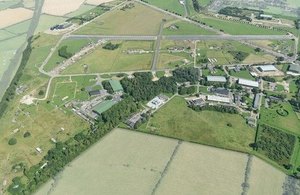UK National Space Propulsion Facility
The UK Space Agency is investing £4.12m in a National Propulsion Test Facility, giving the UK a new facility for space technology testing.

Aerial view of Westcott Venture Park. Credit: Westcott Venture Park.
The UK Space Agency is investing £4.12m in a National Propulsion Test Facility, giving the UK a new facility for space technology testing. The facility will allow UK companies and academia to test and develop space propulsion engines. The planned facility will be based at Westcott in Buckinghamshire, with its strong history of rocketry research for defence and space development, building on existing facilities.
The UK Space Agency investment will add new capabilities for the UK space sector. Government funding will:
- create a new vacuum facility at the Westcott propulsion test site. When used together with the existing industry owned rocket firing test cells, this will allow the simulation of high altitude testing of thrusters up to 2kN
- upgrade an existing industry owned test chamber to improve capabilities in the 25N thrust range
- open the facilities, alongside a smaller 1N thruster test chamber at the site, for the community to use
The UK’s Science and Technology Facilities Council (STFC), through its RAL Space facility will act as an independent broker for facility access. The European Space Agency (ESA) will be advising and overseeing the initial detailed design phase before a review in the autumn to move to full implementation.
This investment builds on what is already a world-class UK space propulsion sector. One of the industry stakeholders in the project, offering their facilities as part of the National Propulsion Test Facility, is Moog-UK. Moog-UK’s LEROS 1b engine recently placed the NASA Juno spacecraft into orbit around Jupiter following a 5-year journey to the gas giant.
Katherine Courtney, Interim CEO of the UK Space Agency said “Our investment in a National Space Propulsion Facility will add several new capabilities to the UK space sector and build upon what is already a world-class UK space propulsion sector.
Opening these facilities up to UK companies and academia will allow them to develop and test future propulsion engines. We hope this will develop the UK’s competitive edge in space propulsion and produce the next generation of propulsion engines. We hope that UK companies will continue to make successful contributions to international missions, such as the LEROS 1b engine involved in JUNO.”
The new capability will allow cost-effective development and testing of even more impressive engines for interplanetary travel, as well as for the significant commercial telecommunications satellite market. Other UK users of the facility, via the Airborne Engineering test chamber, are expected to include Reaction Engines Limited, who are currently testing advanced rocket nozzle technology for the SABRE engine.
With the facility investment from the UK Space Agency, who will also chair the Steering Board for this national facility, and with STFC’s RAL Space team bringing experience of test facility management to the project, this is an excellent example of UK cross-government, industry and ESA collaboration which will benefit the immediate stakeholders involved in the project, as well as the wider propulsion community by opening access to the facility.
Additional to this, Buckinghamshire Thames Valley LEP are investing their own funding in an Innovation / Incubation Centre and a skills training hub – both of which will support the space sector. These investments have come about as a result of the commitment that Buckinghamshire Thames Valley LEP has demonstrated to support the growth of the space sector and is consistent with the Innovation and Growth Strategy aspiration for LEPs to use local funding to support the space sector.